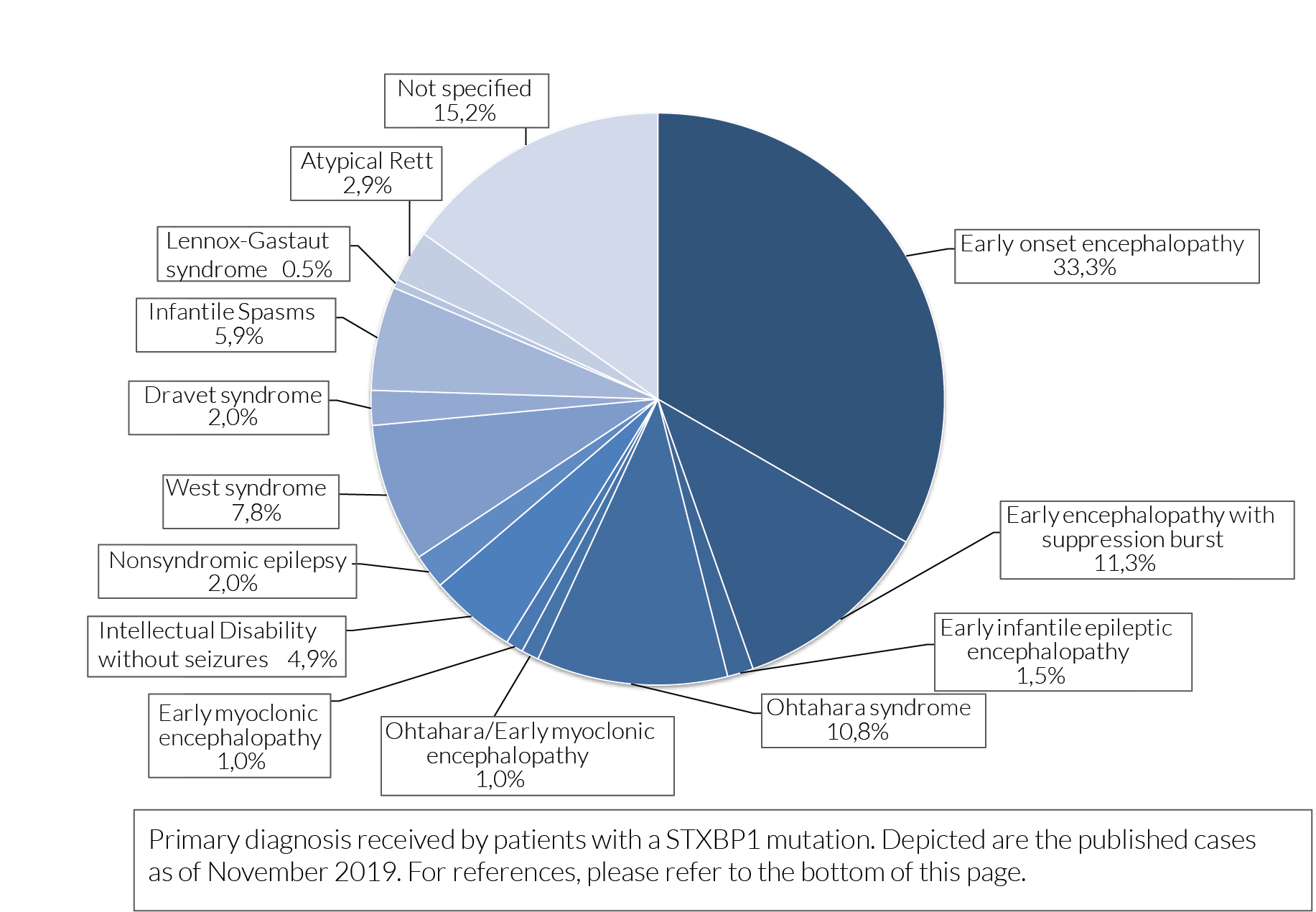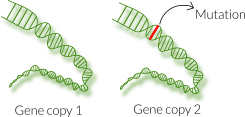Clinical information
This page is written to provide background information on STXBP1-Encephalopathy, intended for patient families and others interested in the basic principles of this disease.
N: Deze webpagina bevat achtergrondinformatie over de basisprincipes van STXBP1-Encefalopathie voor patiënten, familieleden en andere geïnteresseerden.

What is STXBP1 Encephalopathy?
N: Wat is STXBP1-Encefalopathie?
STXBP1 is one of the many thousands of genes in our DNA. In 2008, researchers concluded that small changes in the DNA sequence (mutations) of this gene cause Ohtahara syndrome (Saitsu et al., 2008). Since then, more reports have come out identifying STXBP1 mutations as a cause for several other neurodevelopmental diseases (see figure below). Most of these reports are nicely summarized in the review paper Stamberger et al., 2016).
N: STXBP1 is een van de vele duizenden genen in ons DNA. Onderzoekers concludeerden in 2008 dat kleine veranderingen in de DNA sequentie (mutaties) van dit gen het Ohtahara syndroom veroorzaken (Saitsu et al., 2008). Sinds dat moment zijn er verscheidene wetenschappelijke artikelen gepubliceerd waarin STXBP1-mutaties als oorzaak voor verschillende andere neurologische ontwikkelingsziektes werden geïdentificeerd (zie de figuur hieronder). De meeste van deze wetenschappelijke artikelen worden samengevat in de review Stamberger et al., 2016).
Symptoms
Patients with an STXBP1 mutation can experience a variety of symptoms. The most characteristic symptoms are intellectual disability and epilepsy (95% of the patients), but many patients suffer from additional symptoms, such as movement disorders (e.g. muscle hypotonia, ataxia) or neuropsychiatric features such as autism spectrum disorder.
N: Symptomen
Patiënten met een STXBP1-mutatie kunnen verschillende symptomen ervaren. Veelvoorkomende STXBP1-E symptomen zijn een verstandelijke beperking en epilepsie (95% van de patiënten), maar veel patiënten hebben ook aanvullende symptomen, zoals bewegingsstoornissen (bijvoorbeeld spierhypotonie of ataxie) of neuropsychiatrische afwijkingen, zoals autisme.
Incidence
Mutations in STXBP1 are rare. A recent estimation (based on the Danish population) is that 1 in approximately 90.000 children is affected by a disease-causing change in STXBP1 (Stamberger et al., 2016). Patients are diagnosed by genetic testing after visiting a clinic, typically soon after birth.
N: Incidentie
Mutaties in het STXBP1-gen zijn zeldzaam. Volgens een recente schatting (gebaseerd op de Deense populatie) heeft ongeveer 1 op 90.000 kinderen een ziekteveroorzakende mutatie in STXBP1 (Stamberger et al., 2016). Patiënten worden gediagnosticeerd met behulp van een genetische test in het ziekenhuis, vaak direct na de geboorte.
Treatment
To date, there is no therapy known that treats STXBP1-E patients beyond symptomatic treatments, for example using antiepileptic drugs. Providing new strategies for developing therapies for STXBP1 patients is another long-term goal in our research.
N: Behandeling
Tot op de dag van vandaag is er geen behandeling voor STXBP1-E, behalve symptomatische behandeling met bijvoorbeeld anti-epileptica. Een belangrijk doel van “ons onderzoek”:http://cncr.nl/stxbp1/our_research op de lange termijn is daarom het bedenken van nieuwe strategieën voor de ontwikkeling van nieuwe therapieën.
About the nature of STXBP1 mutations
N: De aard van STXBP1-mutaties
STXBP1 Encephalopathy is typically caused by a heterozygous mutation
Humans, as well as most animals and plants, have two copies of each of their genes. STXBP1-E patients generally have a mutation only in one of the two copies, while the other copy is unaffected. This is called a heterozygous mutation.
N: STXBP1-Encefalopathie wordt meestal veroorzaakt door heterozygote mutaties. Mensen hebben, net als de meeste dieren en planten, twee kopieën van elk gen. STXBP1-E patiënten hebben in het algemeen alleen een mutatie in één van de twee kopieën van het STXBP1-gen, waarbij de andere kopie onaangetast is. Dit wordt een heterozygote mutatie genoemd.
STXBP1 mutations are typically ‘de novo’
STXBP1 disorders typically arise in families ‘de novo’ (Latin for ‘new’). This means that the mutation in the STXBP1 gene occurs for the first time in the affected patient, and is not present in the (grand)parents. Instead, when a mutation is de novo, the mutation has occurred spontaneously and randomly in the germ cells of one of the parents or in the fertilized egg. Every person carries many de novo mutations, but very often these mutations are not in essential parts of our DNA and do not affect our health. It is relatively rare that de novo mutations occur in an essential part of our DNA and that a single mutation has a large impact on our health, as is the case for STXBP1 mutations.
N: STXBP1-mutaties zijn over het algemeen ‘de novo’
STXBP1-Encefalopathieën ontstaan in de meeste gevallen ‘de novo’ (Latijn voor ‘nieuw’). Dit betekent dat de mutatie in het STXBP1-gen voor het eerst voorkomt in de patiënt en niet is overgedragen van zijn/haar (groot)ouders. Wanneer een mutatie de novo is ontstaan, is deze spontaan en willekeurig ontstaan in de geslachtscel van een van de ouders of in de bevruchte eicel. Elk individu draagt vele de novo mutaties met zich mee, maar vaak komen deze voor in niet-essentiële delen van ons DNA en zijn daarom niet schadelijk voor onze gezondheid. Het is relatief zeldzaam dat een de novo mutatie in een essentieel deel van ons DNA ontstaat en daardoor een grote impact op onze gezondheid heeft, zoals bij STXBP1-mutaties.
Links to external webpages and online communities for STXBP1-E
N: Links naar externe websites en online gemeenschappen voor STXBP1-E
The website of Orphanet provides information on rare diseases such as STXBP1-E. You can use their directory of expertise centers to find a center close to your home. In the Netherlands, there are three centers located in Amsterdam, Rotterdam, and Nijmegen.
N: De website van Orphanet geeft informatie over zeldzame ziekten zoals STXBP1-E. U kunt hun lijst van expertisecentra gebruiken om een centrum bij u in de buurt te vinden. In Nederland zijn er drie centra in Amsterdam, Rotterdam en Nijmegen.
The following section provides links to websites hosted by patient communities in multiple countries:
N: Het volgende gedeelte bevat links naar websites die worden gehost door patiëntengemeenschappen in meerdere landen:
STXBP1 disorders foundation: The STXBP1 disorders foundation, based in the USA, is dedicated to raising awareness of STXBP1-E among parents, physicians, scientists, and pharmaceutical innovators. The foundation was created by a group of dedicated parents. They are focused on advocacy, driving research, and providing the families and their physicians with information and resources. We work together with the foundation to increase awareness and to provide resources to the STXBP1-E community. Please visit their website for more information and events.
N: De STXBP1 disorders foundation, gelegen in de VS, heeft als doel bewustwording van STXBP1-E bij ouders, dokters en artsen, onderzoekers en farmaceutische instanties. De foundation is opgericht door een groep ouders en richt zich op belangenbehartiging en onderzoek, en voorziet families en dokters van informatie en hulpbronnen. Wij werken samen met de STXBP1 disorders foundation om de bewustwording omtrent STXBP1-E te vergroten en hulpbronnen te verstrekken aan de STXBP1-E gemeenschap. Bezoek hier hun website voor meer informatie en events.
German STXBP1 website: stxbp1.de
Spanish STXBP1 website: stxbp1.es
Italian STXBP1 website: stxbp1.it
Dutch facebook group: facebook.com/Stxbp1GeneticDisorder
Get in touch with us
N: Neem contact met ons op
We hope to gather information about STXBP1 mutations observed in patients and their symptoms from many STXBP1-E patients. We work with local clinicians as well as with clinicians worldwide to gather such information and we are very interested to get in touch with patients carrying an STXBP1 mutation and their caregivers. If you are interested in our research and would like to know how you can help further it, please send us an email at stxbp1@amsterdamumc.nl.
N: Wij hopen zo veel mogelijk informatie te verzamelen over de STXBP1-mutaties die in patiënten worden gevonden en de symptomen die zij ervaren. Om deze informatie te verzamelen, werken we samen met zowel lokale artsen als artsen wereldwijd. Ook komen we graag in contact met STXBP1-patiënten en hun zorgverleners. Als u geïnteresseerd bent in ons onderzoek en wilt weten hoe u ons kunt helpen, stuur ons dan een email naar stxbp1@amsterdamumc.nl.
Reference list primary clinical diagnoses
N: Bronnenlijst primaire klinische diagnoses
1, 2, 3, 4, 5, 6, 7, 8, 9, 10, 11, 12, 13, 14, 15, 16, 17, 18, 19, 20, 21, 22, 23, 24, 25, 26, 27, 28, 29, 30, 31, 32, 33, 34, 35, 36, 37, 38, 39, 40, 41, 42, 43, 44, 45, 46, 47, 48, 49, 50, 51, 52, 53, 54, 55, 56, 57, 58, 59, 60
Last update: March 6th 2023
N: Laatste update: 6 Maart 2023

